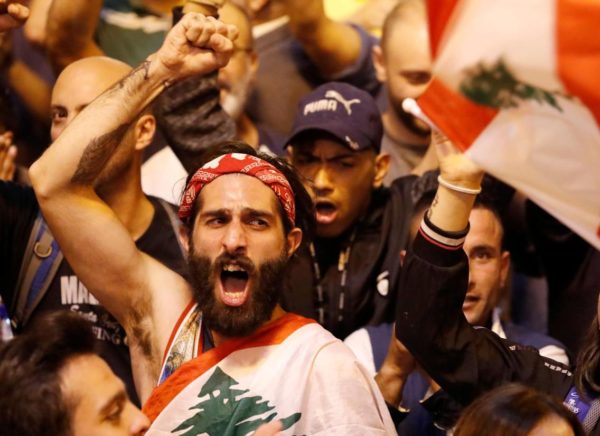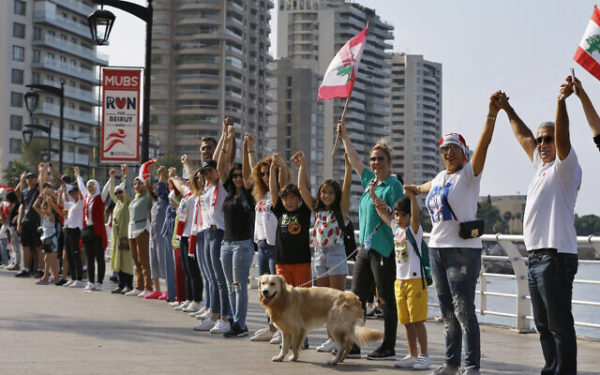
From Beirut to Tripoli, Lebanese demonstrators are defying sectarian stereotypes in startling ways.
What began as protests against government plans to increase taxes amid blatant corruption has turned into massive nationwide demonstrations threatening the foundations of Lebanon’s sectarian political system.
Looking at the crowds, it is obvious that this is a revolution of millennials. It is not a violent movement, save for a few isolated events. If anything, it is the world’s largest outdoor festival: Tens of thousands across the country sing, dance, meet, and laugh. The legendary Lebanese joie de vivre is so obvious that a famous Egyptian social media figure tweeted, “When you Lebanese are done with your revolution, please come to Egypt to organize our next one.”

In a region where demonstrations during the Arab Spring typically started after Friday prayers and where women, although accepted, would not feel totally safe, Lebanon stands out. There is no anger toward those of other religions, but the dress code and attitudes are entirely devoid of any conventional or religious norms.
The protests defy sectarian stereotypes in startling ways. Tripoli’s Nour Square is filled with tens of thousands of protesters. This poor, traditional Sunni city known for its fundamentalist movements and often referred to as Lebanon’s Kandahar (the Afghan Taliban stronghold) is dancing to the tune of rap and electronic music, lending it a progressive image that stuns most Lebanese.
What is even more surprising is that demonstrators in Tripoli are chanting for Sour, a poor Shia city where local mobsters attacked protesters, defying the region’s Sunni-Shia bloody divide. They sing, “Sour, Sour, Sour, for you we will “sour”—a play on words, as sour is also the Arabic word for “revolt.”
The following day, protesters in Sour echoed those lyrics, singing their own songs of love for Tripoli: “We want you to hear in Nour”—that is, Tripoli’s city center—“how much we love you in Sour!”
This is the largest popular blow to date against sectarian narratives that have devastated the region from Yemen to Syria.
Lebanon, long hostage to the Iran-Saudi conflict, is now witnessing protesters clamoring, “No to Iran—No to Saudi.”
Ten days ago, Hassan Nasrallah, the leader of Hezbollah and most powerful man in the country, gave a long-awaited speech broadcast on television. He asked the Lebanese to calm down and told them that the government shouldn’t resign. Protesters’ criticism against the Christian president’s powerful son-in-law Gebran Bassil, though nothing new, surprised everybody due to its sheer intensity. But protesters in Shia areas contested Nasrallah for the first time. Likewise, Sunni leaders were strongly challenged in their strongholds.
The demonstrations also transcend geographic boundaries. The capital has before filled with hundreds of thousands of protesters, but now, for the first time, the movement is affecting all regions of the country, including the poorest cities where local sectarian leaders usually enjoy a strong grip on the population. Estimates of the number of demonstrators vary from a million to 1.5 million, a staggering figure in a country of four million, arguably making it the largest demonstration ever. Members of the Lebanese diaspora have organized sit-ins in Sydney, New York, São Paulo, Paris, London, and other cities across all continents.
The future of this movement is as unknown as its outbreak was unexpected. The Lebanese army has refused so far to use force to stop it. But sectarian leaders sent their thugs to downtown Beirut more than once before security forces intervened.
More worrying is the movement’s lack of political leadership, which is both its strength and weakness. And since all political parties have lost credibility, and all are targets of citizens’ anger, none can coopt the movement. But the civil society activists who lead the protests are divided and disorganized; they reject sectarian parties but cannot present themselves as the alternative.
The movement was starting to slow down last week as a result of violence and political pressure when the unexpected resignation of the prime minister on Wednesday gave it a second life. Despite this initial success, the protest movement has no clear way forward. It is caught between a corrupt, incompetent government, and a weak, divided opposition. Nor can it really count on foreign support; as the country faces an economic and political collapse, the international community likely has no choice but to continue to back the existing government.
In this context, the resignation of the cabinet opens the door for the most viable solution, which appears to be the formation of a technocratic government independent from and above all political parties. Some Lebanese leaders are open to the idea, given the urgency to avoid a major financial and economic collapse but it is clearly a threat to an establishment that thrives on patronage and corruption. In fact, it’s hard to imagine anything other than a qualified, independent cabinet to inspire trust, calm down jittery financial markets, address the immense pressure on the Lebanese pound and convince citizens to get off the streets and accept more sacrifice to rebalance the budget deficit.
Even before the latest events, Lebanon was facing a surfeit of challenges: 1.5 million refugees, which makes it the country with the highest number per inhabitant; the world’s third largest public debt as a percentage of GDP; arguably the world’s most powerful non-state actor, Hezbollah; and a looming financial collapse. Add to this a nationwide protest against the establishment and many perils ahead.
Lebanon will need yet another miracle to avoid plunging into chaos.
Leave a Reply
You must be logged in to post a comment.